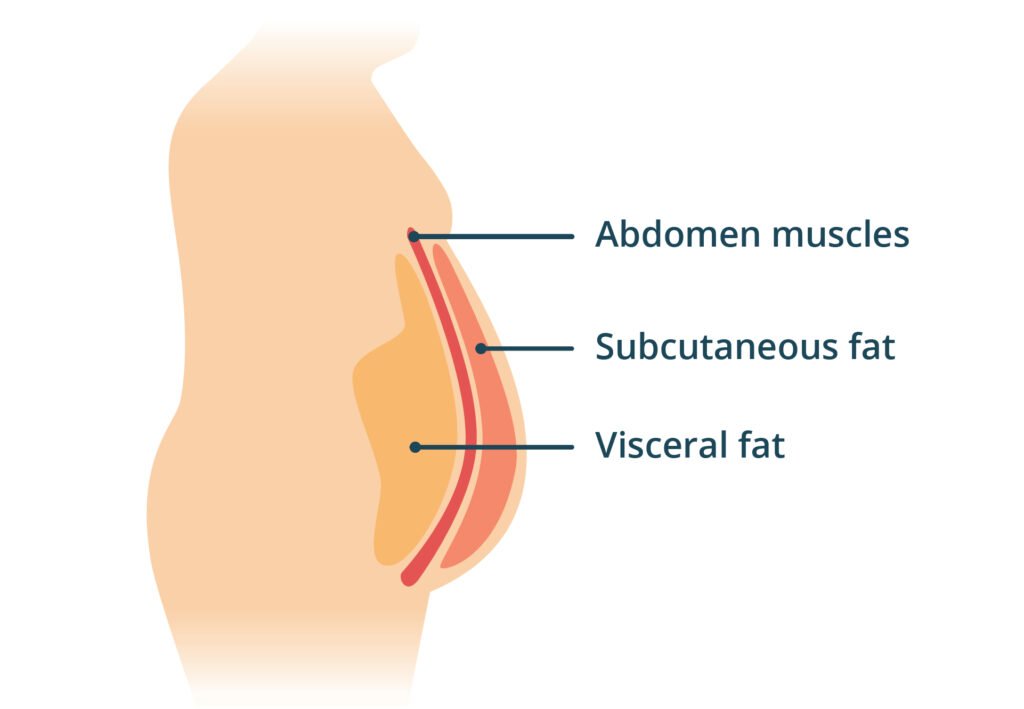
The Health Risks of Visceral Fat
Understanding Body Fat: The Hidden Health Risks of Visceral Fat and How to Combat It
Introduction
Let’s clear up a common misconception: not all body fat is the same. While we often focus on how fat looks on the outside, the type and place it’s stored in our bodies can have a huge impact on our health. Enter visceral fat—the sneaky type that wraps itself around your organs and poses serious health risks. In this easy-to-read guide, we’ll dive into what visceral fat is, its dangers, compare it to the more visible subcutaneous fat, and arm you with practical tips to tackle this under-the-radar health culprit.
The Health Risks of Visceral Fat
Visceral vs. Subcutaneous Fat: What’s the Difference?
Understanding the difference between visceral and subcutaneous fat is crucial for spotting potential health risks. Subcutaneous fat is the type you can see and pinch; it lies just under your skin. On the other hand, visceral fat is more insidious, hiding around your vital organs like the liver, pancreas, and intestines. This internal buildup can lead to significant health challenges.
Here’s the catch: visceral fat isn’t just sitting there. It’s active and releases substances that can cause inflammation. Chronic inflammation can set the stage for serious conditions such as:
– Heart Disease: That excess visceral fat can lead to plaque building up in your arteries, increasing your risk of heart attacks and strokes.
– Type 2 Diabetes: This fat can mess with insulin sensitivity, which is the body’s way of managing blood sugar.
– Cognitive Decline: Some studies suggest that high levels of visceral fat in young adults could lead to a greater risk of dementia as they age.
– Certain Cancers: Research is now linking visceral fat to higher risks of certain cancers, including breast and colon cancer.
The Health Crisis of Excess Visceral Fat
Recent studies have thrown some alarming numbers into the mix: if you’re a woman with a waist measurement over 35 inches or a man whose waist exceeds 40 inches, your risk for these serious conditions shoots up. That’s why keeping an eye on your waistline isn’t just about looking good—it’s about protecting your health.
Practical Strategies for Reducing Visceral Fat
The silver lining? Visceral fat isn’t a life sentence—it’s something you can manage! Here are some straightforward strategies to help you reduce visceral fat and the risks that come with it.
Strategy 1: Engage in Regular Exercise
Getting moving is key. Aim for 225 to 420 minutes of moderate to vigorous exercise each week. Not sure where to start? Here are some fun options:
– Cardio Workouts: Activities like running, swimming, or cycling burn calories and tackle that fat head-on.
– Strength Training: Pumping iron boosts muscle mass, speeds up your metabolism, and helps you shed fat.
– Everyday Activity: Little things count too! Swapping out driving for walking when you can really adds up throughout your day.
Strategy 2: Prioritize a Fiber-Rich Diet
What you eat plays a big role in managing visceral fat. Focus on a diet packed with soluble fiber—this type of fiber dissolves in water and is found in tasty foods like:
– Oats
– Beans
– Fruits (think apples and citrus)
– Vegetables (carrots and Brussels sprouts are solid choices)
Research shows that adding just 7 grams of soluble fiber a day—that’s roughly the amount in a serving of oatmeal—can lead to noticeable weight loss and a slimmer waistline in just ten weeks!
Strategy 3: Ensure Quality Sleep and Manage Stress
Let’s not forget the importance of catching quality Zs and managing stress. Aim for about 7-8 hours of sleep each night. Here are a couple of tips to help:
– Create a Sleep Routine: Go to bed and wake up at the same time every day to help your body’s internal clock.
– Practice Relaxation Techniques: Whether it’s yoga, meditation, or simply breathing exercises, finding time to unwind can lower your stress levels, which might otherwise contribute to that unwanted belly fat.
How to Apply This Information
Feeling overwhelmed? Don’t worry; you can start making changes today! Here are some simple steps to kick off your journey in reducing visceral fat:
1. Track Your Waist Size: Jot down your measurements each month to see how you’re progressing.
2. Set a Weekly Exercise Goal: Find physical activities you enjoyable—after all, working out shouldn’t feel like a chore!
3. Revamp Your Meals: Take a moment to plan out a week’s worth of healthy meals that focus on whole foods, fiber, and plenty of fruits and veggies.
4. Create a Sleep-Friendly Environment: Cut down on screen time before bed to give yourself the best chance at quality sleep.
Conclusion
Understanding the ins and outs of body fat—especially visceral fat—is crucial for embracing a healthier, happier life. The risks tied to too much visceral fat are real, but it’s never too late to take control. By getting active, eating a fiber-rich diet, sleeping well, and managing stress, you can significantly reduce your chances of developing chronic health conditions linked to visceral fat.
So, what are you waiting for? Let’s start this journey together! Feel free to comment below with your thoughts or experiences. Sharing is powerful, and we’re in this together!
Hashtags: #visceral #health #risks #just #fiber #body #type #here #some #sleep #what #subcutaneous #like #lead #managing
